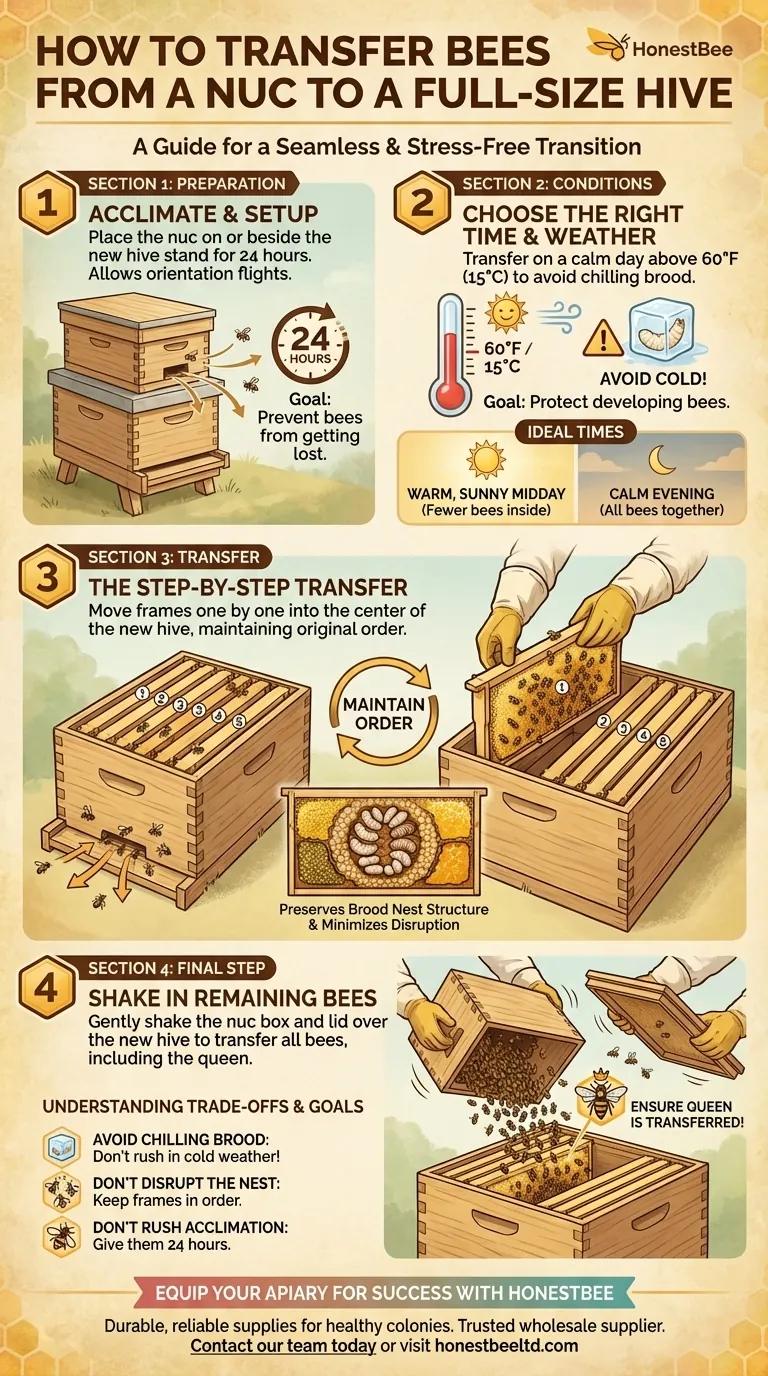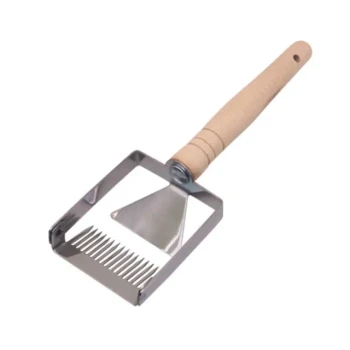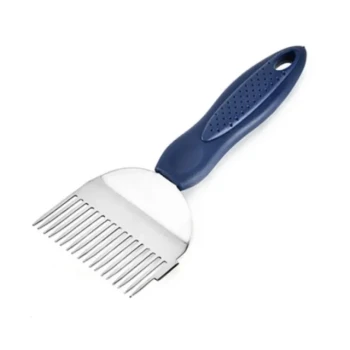To transfer bees from a nuc to a full-size hive, you will physically move each frame from the nucleus box directly into the larger hive body. The key is to maintain the original order and orientation of the frames to preserve the colony's brood nest structure. Any bees remaining in the nuc box or on its lid are then gently shaken into the new hive to ensure the entire colony, especially the queen, has been transferred.
A successful transfer is less about the physical act of moving frames and more about proper preparation and timing. Your primary goal is to minimize stress on the colony by providing a stable transition into their new, larger home.

Preparing for a Seamless Transfer
Before you open the nuc, proper setup is crucial. The environment and the colony's orientation play a significant role in reducing the stress of the move.
Acclimating the Colony
It is a best practice to let the bees acclimate for 24 hours before the transfer. Place the closed nuc box directly beside or on top of the permanent hive stand where their new hive will be.
This allows the bees to calm down after the stress of travel and perform orientation flights. They will mark this precise location as their home, ensuring they return to the new hive after the transfer is complete.
Choosing the Right Conditions
Weather is a critical factor. The single most important rule is to avoid transferring on days below 60°F (15°C).
Opening the hive in cold temperatures can chill the brood (the eggs, larvae, and pupae), which can be fatal to the developing bees and set the colony back significantly. A calm, mild day is ideal.
The Ideal Time of Day
You have two excellent windows for performing the transfer, each with its own advantages.
- A warm, sunny midday: At this time, many forager bees are out of the hive. This means you are dealing with fewer bees inside the box, which can make the process calmer and easier to manage.
- A calm evening: Transferring in the late evening ensures all the foragers have returned home. This guarantees the entire colony moves together, but it also means the hive is at its maximum population.
The Step-by-Step Installation Process
With your preparations complete, the physical transfer is straightforward and should be done calmly and deliberately.
Preparing the Hive
Have your new hive body ready on its stand. It should be equipped with the appropriate number of empty frames to fill the space not occupied by the nuc frames. For a standard 10-frame hive, you will add 5 empty frames beside the 5 nuc frames.
Transferring the Frames
Gently open the nucleus box. One by one, lift each frame out and place it into the center of the new hive body.
It is critical to keep the frames in the exact same order they were in the nuc. The queen lays eggs in a specific pattern, and the bees organize their resources (pollen and honey) around this brood nest. Maintaining this structure minimizes colony disruption.
Getting Every Bee
Once the frames are moved, a cluster of bees will likely remain in the nuc box. To move them, hold the box over the new, open hive and give it a firm shake to dislodge the bees. Do the same with the nuc lid.
This step is vital to ensure you have transferred the queen, who may not have been on one of the frames.
Understanding the Trade-offs
While the process is simple, a few common mistakes can compromise the health of your new colony.
The Danger of Chilling Brood
The most common error is impatience. Moving bees on a cold or windy day can have devastating consequences for the colony's most vulnerable members: the brood. A colony's strength is its population, and losing a generation of new bees is a major setback.
The Cost of Disrupting the Nest
Simply dropping the frames into the new hive in a random order creates chaos for the colony. The bees must work hard to reorganize their resources and the queen must re-establish her laying pattern, wasting energy that could be used for expansion.
The Risk of Rushing Acclimation
Skipping the 24-hour orientation period can lead to confused bees. Bees that were out foraging during the move may return to an empty spot, unable to find their new hive entrance just a few feet away.
Making the Right Choice for Your Goal
Your approach should be dictated by your conditions and experience level.
- If your primary focus is a calm, manageable experience: Transfer the bees on a warm, sunny afternoon when the hive population is lowest.
- If your primary focus is ensuring every bee moves together: Perform the transfer in the late evening, after all the foragers have returned for the night.
- If the weather is borderline or unpredictable: Always prioritize the colony's health by waiting for a warmer, calmer day to avoid chilling the brood.
Ultimately, a successful transfer is defined by a thriving colony, which is achieved by working patiently and deliberately to meet their needs.
Summary Table:
| Step | Key Action | Why It's Important |
|---|---|---|
| 1. Preparation | Acclimate nuc for 24 hours on the new hive stand. | Allows bees to orient, preventing them from getting lost. |
| 2. Conditions | Transfer on a calm day above 60°F (15°C). | Prevents fatal chilling of the brood (eggs, larvae, pupae). |
| 3. Transfer | Move frames in original order to the center of the new hive. | Preserves the brood nest structure and minimizes colony stress. |
| 4. Final Step | Shake remaining bees from the nuc box into the new hive. | Ensures the entire colony, including the queen, is transferred. |
Equip your apiary for success with HONESTBEE. A smooth hive installation starts with the right equipment. As a trusted wholesale supplier to commercial apiaries and beekeeping equipment distributors, we provide the durable, reliable supplies you need to support healthy, productive colonies from day one. Let's discuss how our products can help your operation thrive. Contact our team today to request a quote or learn more about our wholesale offerings.
Visual Guide

Related Products
- Automatic Heat Preservation 6 Frame Pro Nuc Box for Honey Bee Queen Mating
- Styrofoam Mini Mating Nuc Box with Frames Feeder Styrofoam Bee Hives 3 Frame Nuc Box
- 4 Frame Plastic Nuc Boxes for Beekeeping Bee Nuc Box
- 5 Frame Langstroth Poly Nuc Corrugated Plastic Nuc Boxes
- Plastic Transporting Bee Packages and Nuc Boxes for Beekeeping
People Also Ask
- What happens if a nuc is left queenless? Prevent Swarming and Colony Collapse
- What is the process of making a nucleus in beekeeping? Master Sustainable Apiary Management
- When should cells be distributed after setting up nucleus colonies? Ensure Queen Acceptance and Colony Success
- What are the benefits of moving nuclei around the apiary? Master Strategic Hive Management
- How can double nucs be expanded for additional frames? A Guide to Vertical Growth



















